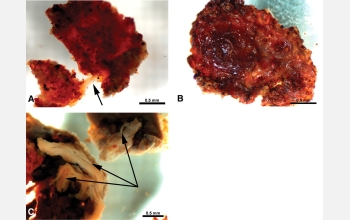|

Press Release 05-048
T. rex Fossil Yields Soft Tissue

Material may contain preserved biomolecules
March 25, 2005
In a discovery that invokes comparisons to Jurassic Park, North Carolina State University paleontologist Mary Schweitzer and her colleagues have extracted soft tissue from the fossilized leg bone of a 70-million-year-old Tyrannosaurus rex specimen. The soft tissue includes intact, still-flexible blood vessels and fibrous material consistent with collagen. Also, electron microscopy reveals round-to-oval bodies virtually identical to the cell nuclei found in the corresponding tissues of ostriches, which, along wtih other birds, are believed to be modern-day descendants of dinosaurs.
Whether the tissue will yield DNA or any other biomolecules remains to be answered.
Schweitzer and her team published the finding in the March 25 issue of the journal Science.
The presence of this novel tissue is not the only surprise from this discovery, says Enriqueta Barrera, a program director in the National Science Foundation's earth sciences division, which partly funded the study. The tissue was once elastic and stretchy, and had the capacity to be dehydrated and rehydrated many times without losing this characteristic. “Although the preservation of soft tissue such as this is not unique in the geologic record, this occurrence goes well beyond what has been observed in the past for dinosaurs, and reinforces the evolutionary link of dinosaurs to birds,” said Barrera.
For more information, see the NC State news release.
-NSF-

Media Contacts
Cheryl L. Dybas, NSF (703) 292-7734 cdybas@nsf.gov
Tracey Peake, NC State (919) 515-3470 tracey_peake@ncsu.edu
Program Contacts
Enriqueta Barrera, NSF (703) 292-8551 ebarrera@nsf.gov
Principal Investigators
Mary H. Schweitzer, NC State (919) 515-3711 schweitzer@ncsu.edu
Related Websites
The Science paper: http://www.sciencemag.org/cgi/content/short/307/5717/1952

The National Science Foundation (NSF) is an independent federal agency that supports fundamental research and education across all fields of science and engineering. In fiscal year (FY) 2009, its budget is $9.5 billion, which includes $3.0 billion provided through the American Recovery and Reinvestment Act. NSF funds reach all 50 states through grants to over 1,900 universities and institutions. Each year, NSF receives about 44,400 competitive requests for funding, and makes over 11,500 new funding awards. NSF also awards over $400 million in professional and service contracts yearly.
 Get News Updates by Email Get News Updates by Email
Useful NSF Web Sites:
NSF Home Page: http://www.nsf.gov
NSF News: http://www.nsf.gov/news/
For the News Media: http://www.nsf.gov/news/newsroom.jsp
Science and Engineering Statistics: http://www.nsf.gov/statistics/
Awards Searches: http://www.nsf.gov/awardsearch/
| 


